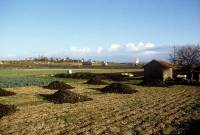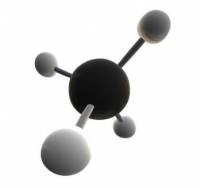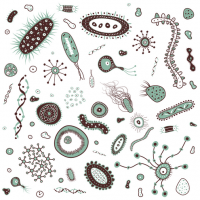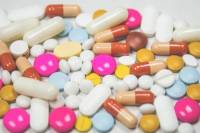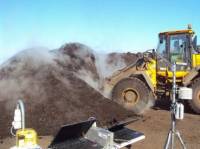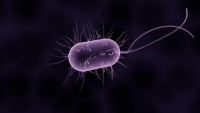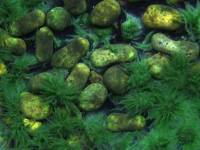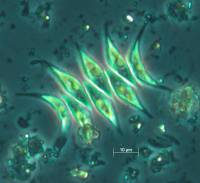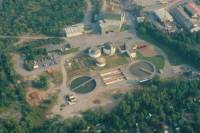Dry anaerobic digestion of solid waste |
Anaerobic dry digestion is particularly suitable for the recovery and treatment of waste containing small amounts of water (agricultural residues, manure, fermentable fraction of household waste ...). However, operation at a high solids content causes biological (kinetic, inhibitions, etc.) and physical (rheology, material transfer, etc.) limitations in the digesters. |
|
Physico-chemical and biological pretreatment of solid residues |
The bioconversion of solid residues can be limited by the low accessibility of fermentable compounds. We study the coupling of anaerobic digestion and fermentation with physicochemical and biological treatments. The objectives of the research are to improve the yield of biogas or hydrogen and fermentative metabolites of various substrates such as lignocellulosic biomass, sludge, algae, animal by-products and slurry and manure. |
|
Digestate |
During the treatment and recovery of organic residues, organic waste products generated must meet agronomic quality criteria including efficacy and safety. Bioprocesses must therefore be designed according to the antagonisms between the services expected in search of a compromise. Finding a compromise between agronomic and energy recovery, among other services rendered, involves modeling and control of organic waste treatment processes in order to better design them, adapt them to downstream needs and think of innovative sectors. |
http://mediatheque.inra.fr |
Biomethanation |
Biomethanation allows the conversion of hydrogen and carbon dioxide or carbon monoxide to methane. This bioconversion can present an interesting technological brick in the case of biomass and organic residue processing and renewable energy production sectors. Research is needed to improve understanding of key processes to consider optimization of the biomethanation process. |
|
|
Valorisation of agri-food by-products |
Optimal valorization of by-products of the agro-food industry, through the adaptation of pretreatments used to improve the biodegradability of biomass and agro-food residues towards the extraction of high value-added molecules before bioenergy production. |
|
Biohydrogen Fermentation and Biomolecules |
In addition to anaerobic digestion processes, fermentative processes provide added value to organic matter recovery processes, in the form of biohydrogen and / or biomolecules of industrial interest. Research on this theme focuses on the choice of the best inputs and their pre-treatment, the optimization of bioprocesses, and their integration into a more global environment biorefinery framework. |
|
Instrumentation and control of bioprocesses and microbial ecosystems |
Under certain conditions, especially when one seeks to optimize their operation, bioprocesses present risks of destabilization that require the establishment of control laws. The scientific problematic concerns the (possibly "optimal") control of dynamical systems - sometimes large - uncertain, partially observed, non-linear, non-stationary and / or disturbed. |
all-free-download.com |
Measure and control of microbial diversity |
Most environmental bioprocesses are governed by microorganisms. Microbial communities are generally very diverse with several hundred interacting species, and highly dynamic because there is a significant functional redundancy. The objective of the research carried out in the laboratory is to better characterize (appropriate measures of diversity), to control (artificial, simplified or synthetic ecosystems), and to actively control the fate of communities (microbial interaction engineering) to catalyze biological bioconversions. interest. |
http://www.clipartpanda.com |
Engineering interactions in microbial ecosystems |
Fermentation or methanation of organic substrates involves the activity and interaction of a wide range of microorganisms. Most of the time, the availability of an inoculum determines its use in a bioprocess, but not from the point of view of its functional relevance. We are working to determine the ecological principles that would predict the relevance of a microbial community to degrade a given substrate. |
|
Biomimicry |
Anaerobic digestion processes do what animal digestive systems have been doing for a very long time, i.e. transform biomass under anaerobic conditions. On different common aspects such as pretreatment, processes and microbiota, animals have optimized their digestion according to their different substrates. The biomimetic approach aims at identifying and copying these living solutions. |
|
|
Modeling |
The BSLB's work in this area aims to: - to develop models for simulation and for control and optimization that require different types of models
- to apply concepts such as thermodynamics to better describe ecosystem growth
- the use of deterministic and stochastic models for the modeling of diauxie phenomena for the environmental biorefinery
- Explicit study of interactions between all components of microbial ecosystems
|
http://www.clipartpanda.com |
Removal of organic contaminants |
Wastewater and organic waste such as sludge, manure, biowaste contain a wide variety of organic micropollutants. We have developed analytical methods to (i) better understand and model their fate during the treatment of wastewater and solid waste (laboratory and industrial scale) through the evaluation of their bioavailability and (ii) reduce their impact on the receiving ecosystems. |
https://pixabay.com |
Environmental assessment |
The assessment of environmental impacts and benefits is a key element for the environmental biorefinery. To integrate the whole of the die put into play, from the upstream to the downstream, is done via the Analysis of the Cycle of Life. It is in this perspective that the LBE implements this approach through various research projects (clean-up processes, algal biomass valorization processes ...) and contributes to the methodological developments of this conceptual framework, to better characterize the impacts on the environment of human activities. |
http://mediatheque.inra.fr |
Bioaerosols / Airborn microbes |
The air is a means of dissemination for microbes and viruses, whether they are pathogenic or not. Biological processes (methanization, composting, wastewater treatment, micro-algae cultures, etc.) and our indoor lifestyles generate microbial aerosols and new exposures to these microbial aerosols. Thus, in the same way as water and food, the microbiology of the air must be known and its impacts measured. |
|
Fate of pathogenic bacteria during waste treatment |
The research conducted at the LBE concerns the survival and dissemination of pathogenic bacteria on the treatment and recovery of residues derived from human activities. The objective of the research is to improve microbiological risk management on these pathways by providing new insights into the determinants of the survival of pathogenic bacteria in these ecosystems and on underappreciated dissemination pathways such as those by the air vector. |
https://pixabay.com |
Photogranules | |
Cyanobacteria play a major role in biogeochemical cycles on Earth. They are also becoming key players in biotechnological processes such as wastewater treatment through their ability to form phototrophic granules that produce oxygen. In the laboratory, we are working to optimize photogranulation by controlling the conditions favoring this phenomenon. |
|
Microbial bioelectrochemical systems and electro-fermentation | |
Microbial bioelectrochemical systems are electrochemical processes in which microorganisms exchange electrons with an electrode to catalyze reactions of interest. We use them as models for studying microbial interactions and for developing eco-engineering strategies for microbial ecosystems. A recent development of this theme is the electro-fermentation in which polarized electrodes are used to orient and control fermentation reactions. |
|
Coupling microalgae to fermentation effluents | |
The production of microalgae on waste fermentation effluents is a promising approach to environmental biorefinery in which a partial digestion of organic waste by bacteria makes it available to microalgae in the form of volatile fatty acids. Since it is too expensive to sterilize the effluents, fermentation bacteria remain in the system. Research on this topic aims to reveal i) how the main substrates in effluents are used by algae and ii) the significance of algae / bacteria interactions in effluents. |
http://mediatheque.inra.fr |
Information systems | |
LBE has developed several information systems: - SILEX-LBE: online monitoring of dry or liquid degradation processes under anaerobic conditions and microalgae production processes
- ChemFlow: educational information system dedicated to chemometrics
- TyPol: typology of micropollutants for classifying organic contaminants according to properties of environmental interest and molecular characteristics
|
all-free-download.com |
Water Reuse | |
The reuse of wastewater makes it possible to compensate for the decline in direct surface water withdrawals for agriculture and industry, provided that it is able to guarantee sanitary and environmental safety. The LBE works on the one hand on the fate of organic micropollutants and microbiological contaminants during the treatment and during the use of treated water in irrigation, and on the other hand to the optimization of the sector by tools of modelization. |
mediatheque.inra.fr |








